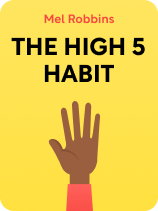

This article is an excerpt from the Shortform book guide to "The High 5 Habit" by Mel Robbins. Shortform has the world's best summaries and analyses of books you should be reading.
Like this article? Sign up for a free trial here.
What’s the key to getting rid of bad thoughts? How should you remind yourself that you’re a worthy and capable person?
The High 5 Habit by Mel Robbins says that giving yourself a high five is the boost of confidence that you need every day, but sometimes negative thoughts are too loud to overcome. To challenge them, she offers a three-step process to help you.
Discover how to get rid of bad thoughts and turn your day around.
How to Address Negative Thoughts
Starting your day with a high five is intended to remind you that you’re worthy. But, throughout the day, you’re still bound to have moments of self-doubt or negative self-talk. Building a High 5 Habit means not just giving yourself a high five every morning but also cultivating a positive attitude—an inner voice that always celebrates and affirms you. A positive attitude requires you to know how to get rid of bad thoughts that tear you down rather than lift you up.
(Shortform note: According to Jon Acuff, author of Soundtracks, it can be difficult to address negative thoughts because the human brain has a natural tendency toward negative overthinking. He explains that the brain responds to minor negative events and significant trauma in the same way, by internalizing the experience and its consequences. This makes it easier for you to remember your failures rather than your successes, often resulting in an exaggerated negative opinion of yourself.)
Robbins offers a three-step process to help you transform negative thoughts as they arise.
Step 1: Interrupt the negative thought as it occurs. Robbins recommends simply redirecting your focus anytime you notice a negative thought about yourself come up.
(Shortform note: Acuff recommends a similar three-step strategy for changing your internal soundtrack. However, he offers more specific suggestions on how to interrupt negative thoughts. First, he suggests that you critically examine the negative thought by asking yourself whether the thought is true, if it helps you accomplish your goals, or if it makes you feel good. If it does none of those things, he argues, it’s not worth dwelling on. He also acknowledges that it’s possible to recognize that a thought is untrue, unhelpful, and unkind, and still remain fixated on it anyway. In this case, Acuff recommends taking a mental break and finding an activity that helps your brain relax.)
Step 2: Replace the negative thought with a meaningful affirmation, for example, “I’m capable of building the life I want.” She emphasizes that affirmations only work if you truly believe what you’re saying, so try out a few to find some that work for you. Once you find an affirmation that rings true, she recommends writing it down somewhere where you’ll see it often, maybe on your bathroom mirror where you’ll see it every time you give yourself a high five.
(Shortform note: Acuff adds that if you’re having trouble finding a positive thought that works, try inverting the negative thought. For example, if you’re a runner, and one of your negative thoughts is “I’ll never be able to run a marathon,” you can flip this thought upside-down and tell yourself “I have what it takes to go the distance.”)
Step 3: Finally, take an action step that proves your affirmation to be true. For example, if your affirmation is “I learn something new every day” then you could end your day by sharing something you learned with a friend or family member.
(Shortform note: In addition to taking action on your positive affirmation, Acuff recommends you repeat positive thoughts until you internalize them. Acuff suggests repeating your affirmation out loud every day even if it feels awkward—studies suggest that talking to yourself aloud is more effective than speaking internally.)
Reframe Unproductive Emotions
Often these negative thoughts are tied to complicated underlying emotions like fear, doubt, jealousy, and guilt. Robbins argues that addressing the emotions at their root will better equip you to interrupt the negative thoughts that stem from those emotions. She offers suggestions for how to reframe the underlying emotions that lead to negative self-talk.
The first emotion is fear, which is one of the biggest barriers to people pursuing their dreams. Robbins explains that people are most often afraid of failure, especially when it comes to going after what they want most. But she suggests that you only fail when you don’t act to create the life you want. If there’s something you’ve always wanted to do, you’re the one who has to take steps to make it happen. She suggests that instead of letting fear paralyze you, reframe your fear as motivation to take action. Try setting a deadline or writing down the steps you need to take to accomplish your goals. According to Robbins, the key is to take a step toward your dream. No matter how small that step is, it has the potential to move you from fear to action.
The second emotion that leads to negative self-talk is doubt. In the pursuit of your dreams, you’re bound to have moments of doubt where you wonder if you’re capable of tackling the challenges you face. Instead of listing the reasons why you aren’t ready or able, reframe the challenge as a learning experience. Robbins argues that each setback has the potential to teach you something that you need to know. Reframing doubt as a normal part of the growth process and an opportunity for self-reflection allows you to shift your focus from paralyzing uncertainty to curiosity and possibility.
The third emotion is jealousy. It’s natural to compare ourselves to others and to feel jealous. Robbins explains that while many people think of jealousy as something to be avoided, the feeling can actually be a useful source of information. She argues that jealousy is a tool that helps show you what you want and what you deserve. If you’re jealous of something, it means that’s something that you want. So instead of wallowing in jealousy, use it. Try to reframe jealousy as inspiration. If you want something, what do you need to do to get it? Robbins recommends using the people you’re jealous of as a resource. For example, if you’re jealous of a friend who has launched a new business, don’t talk about them—talk to them. They have the potential to be a valuable source of advice and mentorship. She reiterates that someone else’s success or happiness doesn’t limit your potential for success or happiness. There’s plenty to go around.
The last emotion that can lead to a flood of negative thoughts is guilt. Robbins differentiates between two types of guilt—informative guilt (what Robbins calls productive guilt), which informs you when you’ve done something wrong that you need to fix, and unhelpful guilt (what Robbins calls unproductive guilt or shame), which makes you feel like you’re bad because of a mistake you’ve made. If you don’t know what kind of guilt you’re experiencing, ask yourself if what you’re feeling is helping you grow or making you feel worse about yourself. If it’s the latter, you’re probably suffering from unhelpful guilt.
Robbins emphasizes that unproductive guilt is often self-imposed and frequently stems from the decision to prioritize your needs over those of other people. For example, you might feel guilty when you think about making someone angry, hurting them, or disappointing them. Instead, try to reframe the guilt as gratitude. For example, if you feel guilty for showing up late to a meeting because of a flat tire, you can reframe your guilt as gratitude for your colleague’s understanding and patience.

———End of Preview———
Like what you just read? Read the rest of the world's best book summary and analysis of Mel Robbins's "The High 5 Habit" at Shortform.
Here's what you'll find in our full The High 5 Habit summary:
- Why you should start each day by giving your reflection a high five
- How to silence self-doubt and adopt an attitude of confidence and self-love
- The psychology behind why high fives make you feel good






